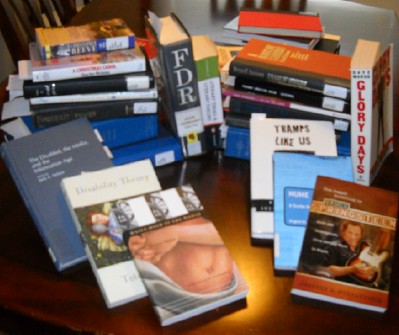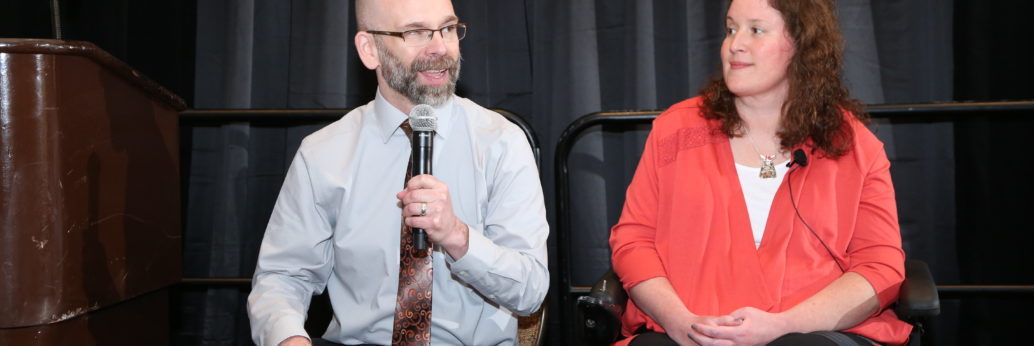
It seems like forever since we’ve written for our blog, but it’s not like we haven’t been writing! We just completed a super-intense six-week summer class for our graduate degree from Central Michigan University. Guess we didn’t anticipate ENG 535 History of Literary Theory would take so much out of us. But thanks to our wonderful professor – Dr. Ron Primeau – and fellow classmates, we really got a lot from this course.
With this, we wanted to share with you the abstracts for our final papers. Interesting thing is that our literary criticism papers, which dealt with literature, art and pop culture, each had incredibly close connections with the disease we both share.
Hope you enjoy these and they both give you some things to think about.
Are We There Yet? Americans with Disabilities’ Role in Literature
by Jennifer Digmann
Christmas dinner with Ebenezer Scrooge. The leader responsible for The New Deal. A mind-bending telepath in charge of a comic book super hero mutant army. A real life Super Man. Two women with waist-high views of the world. What do these things have in common? Believe it or not, they’re all connected through literary theory. They are part of the discourse explored in my paper about how physical disabilities have been handled in literature and different media before and after the Americans with Disabilities Act was signed into law in 1990. This landmark civil rights legislation was crafted to remove literal and figurative obstacles for disabled citizens. The theorists used to address this issue include feminists Adrienne Rich and Annette Kolodny, disability theorists Tobin Siebers and Lennard Davis, and intellectual Michel Foucault. This paper analyzes from various critical approaches—such as reader response, differential, and cultural studies—how physical disabilities are portrayed through Charles Dickens’s character Tiny Tim, President of Franklin Delano Roosevelt, Marvel Comics X-Men character Professor X, actor Christopher Reeve, disabled author Nancy Mairs, and excerpts from my personal blog about living life with a physical disability.
The Boss, in Theory
by Dan Digmann
From national magazines featuring his picture on their covers, a Rock and Roll Hall of Fame Museum exhibit honoring his life’s work, countless arenas selling out his high-energy concerts, and so much more, Bruce Springsteen is a musician, poet, and social activist who gets noticed. Considering Springsteen’s humble beginnings as a struggling artist playing the bar scene on the now rundown New Jersey shore, it isn’t clear what propelled him to his legendary pop culture icon status. This paper—The Boss, in Theory—looks into how a knowledge of critical theory can explain how Bruce Springsteen, after establishing his credibility, has continued to stay socially and culturally relevant since he hit the mainstream with his first album, Greetings From Asbury Park, nearly four decades ago. This is accomplished through applying the critical approaches of theorists such as David Hume, John Fiske, Longinus, Annette Kolodny, and Wolfgang Iser to Springsteen’s music and political actions and how these collectively have affected his passionate fans as well as outspoken nonfans and disinterested observers. This includes a comparison to Shakespeare to explain Springsteen’s lasting impact as well as a reader-response perspective on how Springsteen’s music is helping one longtime fan come to terms with being diagnosed with a progressive chronic illness.
And BTW: We both ended up getting an “A” on our papers 🙂





Your papers sound interesting. I’m not surprised you both got an A. Springsteen and Shakespeare; now that’s an interesting comparison.
LOL, well you BETTER get an A! Really enjoyed reading these, especially Jennifer’s. Great topic. Thanks.
Hi, Judy and Diane! Thanks for your words of encouragement. This likely was the toughest class we’ve had to date, but definitely was among the most enjoyable! How exciting that you could appreciate what we were trying to do with our topics. Cheers!
Great abstracts! Makes me want to read both papers, which is the purpose of a well-crafted abstract. Way to go you two!